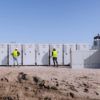Today we join the Brandweer Nederland (Netherlands Fire Officers’ Association) conference of practice. The topic for today is the (fire) safety of solar farms, an issue our asset managers deal with every day. Today is all about sharing knowledge and experiences to make PV firefighting as safe as possible for all stakeholders. You can read the results here.
Sharing knowledge between sectors
A mixed audience is ready for the knowledge session on the fire safety of PV systems. The size of the group alone shows how relevant the subject is. From commercial consultants to the Gelderland fire service and working groups from Rijkswaterstaat (the executive agency of the Ministry of Infrastructure and Water Management), all the participants are keen to learn from each other’s knowledge.
The day begins with a short question and answer session. Which issues does your sector face? Which problems related to PV systems and fire safety do you have to deal with? We hear about requirements imposed by insurers, scope 12 inspections, disconnections and shutdowns of solar farms and similar issues. It’s clear there is a lot of curiosity about the legislation and regulations covering these areas, as well as practical experience.
Fire safety and solar panels: the theory
Let’s start with the theory. What exactly are photovoltaic panels and what risks are associated with them? Niels van Veen from the RIVM (the National Institute for Public Health and the Environment) shares the results of one of their most recent studies. The vulnerability of solar panels to fire is largely determined by the ground under the panels. Thankfully only very minimal quantities of harmful substances are released when solar panels burn, and these are not harmful to the local environment. There is an urgent need for basic knowledge like this in the sector.
Preventing minor technical mistakes
Conversations with all the attendees reveal that the small number of fires that occur in practice are primarily caused by minor technical issues, such as failure to properly close the door of an inverter. It is also said that: “‘Mistakes’ like these show that the PV sector is still in its infancy. The stakeholders still need to learn all the ins and outs of these systems. As such, the first step is to ensure we are all aware of why attention to detail is so important. From installers to firefighters, everyone needs to learn from one another.”
That immediately brings the discussion to the next point. The attendees conclude that the regulations have not kept up with developments in practice and in technology. Because the regulations are out of date, it is particularly important to talk to one another during the design phase of PV systems.
On to a practical example
To immediately turn words into action, the group visits the Biddinghuizen Solar Carport. This is an example of one of the solar farms that Klaer maintains. We follow asset manager Bernd Nijen Twilhaar from the Biddinghuizen Solar Carport to the Lowlands festival site. The Biddinghuizen Solar Carport is a great practical example of an intensive partnership between the fire service, a project developer and other stakeholders.
The knowledge sharing continues at the Solar Carport. Together with Bernd, the fire service share their experiences of the partnership, including examples of good fire safety practices. These include a switch that allows the fire service to shut down (parts of) the Solar Carport without the need to involve the (grid) operator.
Asset manager Bernd and the fire service explain that the process of making the Solar Carport fire safe involved thinking in terms of scenarios. Many questions were asked during the design and development of the solar farm. How do we get there in the event of a fire? How will the firefighting water supply be arranged? Can we create firefighting compartments? Who will shut down the solar farm? Can we limit water damage and the need to shut down the system? The asset managers at Klaer need to take all these issues into account to make solar energy systems fire safe.
The safety of solar energy systems comes first
Although a large group of stakeholders is involved with the development of a solar energy system, in the end they all have the same objective: everyone wants a safe solar energy system and to prevent fire. Working together is very important to reach that goal. Thankfully there’s no shortage of expertise, but it’s not always clear how to make sure it reaches the right place. This makes a day like today a great opportunity to share knowledge and experience.
If you would like to know more about the fire safety of a PV system or how Klaer can help you maintain and monitor your solar energy system, please contact us or schedule an appointment.




